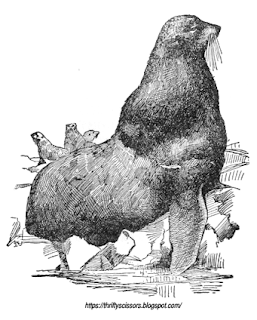 |
| Earless Seal. See many other types at wikipedia. |
A seal is a warm-blooded, air- breathing, animal that lives both in the water and on the land. A few seals are found in the Caspian Sea and Lake Baikal, but, with these exceptions, all seals are inhabitants of the sea. They are divided into two classes, called true seals, which have no external ears, and eared seals.
12 Interesting Facts About Seals In General:
- The seal has a body which is large at the front and tapers toward the tail, like that of the whales.
- It has four legs, which are almost covered by the skin of the body, while in place of the feet are fins or flippers.
- The hind legs are used in swimming, and the fore legs support the animal in an erect position when he is on the land.
- The mouth is large and is surrounded by numerous feelers, resembling those of the cat.
- The eyes are large, with an almost human expression, and the ears are small or entirely lacking.
- The body is covered by thick, woolly fur and long, shining hair, and all is so oily and smooth that it enables the seal to move easily through the "water."
- Seals are air-breathing animals, but they can remain under water for a considerable time.
- They are expert divers and swimmers, but are exceedingly awkward on land.
- Seals inhabit the cool waters of the temperate and polar regions and usually return to the same spot year after year to breed.
- They live in herds, and before they were hunted many of these herds "were of enormous size.
- They frequent rocks in shallow places and icebergs, where they come at breeding time and remain to rear their young.
- Most species are easily tamed, and they often form great attachment for their keepers and are easily taught ingenious and amusing tricks.
 |
| A fur seal rests on the rocks. |
5 Facts About Hair Seals:
- This seal was captured in large numbers off Newfoundland, Labrador, Jan Meyen Island and in the White Sea.
- The inhabitants of Greenland hunted these seals for food and clothing, but they took only a sufficient number to supply their needs.
- In many places these seals have been nearly exterminated by hunters, because the skins made good leather, and a valuable oil was extracted from the blubber.
- The hair-seal industry was really more important than the fur-seal industry, although it did not receive as much attention.
- The danger of exterminating these animals has become so imminent that international agreements restricting the hunting of the animals are routinely drafted signed and updated.
The fur seal or sea bear is highly valued for its fur, which consists of a thick, woolly hair next the skin, very fine and compact, usually of a dark brown color. Over this grows long, coarse hair, which is of some shade of gray. The fur seals are found in the water of the cool temperate or polar regions north and south of the equator.
More About Fur Seals from The Web:
Fur Seals Overcome Extinction On "Resurrection Island"
by National Geographic

No comments:
Post a Comment
Folks, thanks for comments. These are all checked out before publishing. I can not publish spam, doing this negatively reflects upon 'how' my blog ranks and it also will make you look suspicious to those who own this software.